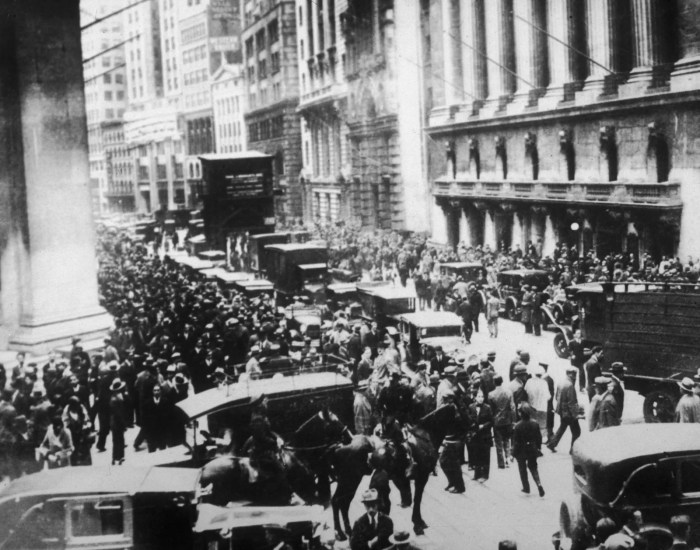Diving into the world of Stock market crashes, we’re about to break down the causes, effects, responses, and lessons learned from these financial rollercoasters. Get ready to ride the waves of economic downturns and investor behavior like never before.
Causes of Stock Market Crashes
Stock market crashes can be triggered by a variety of factors, ranging from economic events to investor behavior and external shocks. Understanding these causes is crucial for navigating the volatility of financial markets.
Historical Events and Economic Factors
- The Great Depression of 1929: The stock market crash of 1929, which led to the Great Depression, was caused by a combination of excessive speculation, high levels of debt, and a lack of government regulation.
- The Dot-Com Bubble Burst: In the early 2000s, the stock market crashed as a result of the burst of the dot-com bubble, where internet companies with high valuations failed to deliver on their promises.
Role of Speculation and Investor Behavior
- Speculation: Speculative trading, where investors buy and sell stocks based on rumors or hype rather than fundamentals, can create artificial market bubbles that eventually burst.
- Panic Selling: During times of uncertainty or negative news, investors may engage in panic selling, leading to a rapid decline in stock prices.
Impact of External Shocks
- Natural Disasters: Events like hurricanes, earthquakes, or pandemics can disrupt global supply chains and economic activity, causing stock markets to plummet.
- Political Events: Geopolitical tensions, trade wars, or unexpected political developments can create uncertainty in the markets, triggering sell-offs and market crashes.
Effects of Stock Market Crashes
When a stock market crash occurs, it can have far-reaching effects on the economy, individual investors, and consumer confidence. Let’s delve into how these crashes impact various aspects of the financial landscape.
Impact on the Overall Economy
Stock market crashes can have a profound impact on the overall economy. They can lead to a decrease in consumer spending, as people become more cautious about their finances. This, in turn, can negatively affect businesses, leading to layoffs and a slowdown in economic growth. Additionally, a stock market crash can erode investor confidence, causing a ripple effect throughout the economy.
Effect on Individual Investors and Portfolios
Individual investors are directly affected by stock market crashes, especially those heavily invested in equities. A market downturn can result in significant losses for these investors, potentially wiping out a substantial portion of their portfolios. This can have long-term consequences, affecting their ability to save for retirement or meet financial goals.
Relationship with Consumer Confidence
Stock market crashes can greatly impact consumer confidence. When people see their investments dwindling in value, they may cut back on spending, leading to a decrease in demand for goods and services. This can further exacerbate economic woes, creating a cycle of decreased consumer confidence and spending. Restoring consumer confidence after a stock market crash can be a challenging task for policymakers and businesses alike.
Responses to Stock Market Crashes

In times of stock market crashes, various entities come into play to address the situation and minimize the impact on the economy and investors. Let’s delve into the strategies employed by governments, regulatory bodies, and financial institutions to manage these crises effectively.
Government and Central Bank Strategies
During stock market crashes, governments and central banks often implement monetary and fiscal policies to stabilize the economy. This may include lowering interest rates, injecting liquidity into the market, and providing stimulus packages to support businesses and individuals.
Regulatory Body Response and Safeguards
Regulatory bodies, such as the Securities and Exchange Commission (SEC) in the United States, play a crucial role in monitoring market activities and ensuring compliance with regulations. In response to market volatility, these agencies may introduce new rules, enhance oversight, and implement safeguards to protect investors and maintain market stability.
Role of Financial Institutions in Risk Management
Financial institutions, including banks and investment firms, play a critical role in managing risk during stock market crashes. They may diversify their portfolios, adjust their investment strategies, and provide guidance to clients to navigate market turbulence. Additionally, these institutions work closely with regulators to ensure compliance with risk management practices and maintain financial stability.
Lessons Learned from Stock Market Crashes
Investors have learned valuable lessons from historical stock market crashes that have shaped their approach to investing. These events serve as cautionary tales and provide insights into how to navigate the volatile nature of the stock market.
Impact of Market Crashes on Investment Strategies
Market crashes have highlighted the importance of diversification in investment portfolios. Investors have realized that spreading investments across different asset classes can help mitigate risk during turbulent times. Additionally, having a long-term investment horizon and avoiding emotional decision-making based on short-term market fluctuations have become key principles in developing resilient investment strategies.
Long-term Effects on Financial Planning
Stock market crashes have underscored the need for robust financial planning that accounts for potential market downturns. Investors are now more inclined to establish emergency funds, maintain a balanced mix of investments, and regularly review and adjust their financial goals based on changing market conditions. The focus has shifted towards creating a solid financial foundation that can withstand market shocks.
Protecting Investments During Market Instability
During periods of market instability, individuals can protect their investments by staying informed, maintaining a long-term perspective, and avoiding knee-jerk reactions. Setting stop-loss orders, rebalancing portfolios periodically, and seeking professional advice can help investors navigate turbulent market conditions with greater confidence. It is essential to remain disciplined and avoid making impulsive decisions driven by fear or panic.
